Jay L. Wile's Blog, page 28
November 20, 2017
Thankfulness Despite Tragedy

I have written about tragedy and faith in previous posts (see here, here, and here). As Christians, we should understand that the pain we experience as a result of tragedy is temporary in light of eternity. We will eventually be in a place where all tears are wiped away (Revelation 21:4), and that should provide us with some measure of comfort. But there’s a big difference between being comforted and being thankful, isn’t there? Can we really be thankful if we experience a serious tragedy?
Yesterday, I preached at my home church, Wesley Free Methodist. I have preached there a few times before, and you can find three of my sermons and many better ones preached by others on the church’s “Weekly Message” page. This sermon was different, however, because it was not the sermon I wanted to give. It was challenging, and if you listen to it, you will hear my voice crack a few times due to emotion. However, I think the message I am trying to impart is important, so I am sharing it here.
You can listen to the sermon by clicking on the “play” icon in the bar below, or you can right-click on the link below the bar and choose “Save Link As” to download it to your device. If the message touches you and you think you know of someone else it might touch, feel free to share it.
http://blog.drwile.com/wp-content/uploads/2017/11/11_19_2017.mp3
November 8, 2017
Please Stop Believing Facebook, Especially When It Comes to Science!

A picture from a high school experiment that has been hyped on Facebook.
As I was scrolling through Facebook, finding my historical twin and learning what my friends are eating, I noticed a post on my wall. It was from someone I know only through Facebook, but I read her work from time to time, because she is a really good writer. Her post contained the picture above and linked to an article entitled, “WiFi Experiment Done By A Group Of 9th Grade Students Got Serious International Attention. THIS Is Why…” She asked if I knew whether or not the results were legitimate.
The experiment went like this: Students took 12 trays of cress seeds and put 6 of them in one room and 6 in another room. The six trays in one room were next to two WiFi routers, while the 6 trays in the other room were nowhere near a router. They tried to keep everything else (temperature, amount of water given, etc.) the same for all 12 trays. The article says:
After 12 days what the result spoke was clear: cress seeds next to the router did not grow, and some of them were even mutated or dead.
Obviously, then, WiFi routers produce something that kills (and apparently mutates) cress seeds.
I told my Facebook friend that the post reminded me of something that was popular a few years ago. It was an experiment where a person watered a plant with regular water and watered another plant with water that had been in a microwave oven. After several days, the one watered with microwaved water died, while the other one flourished. Obviously, then, microwave ovens are bad for you. Of course, the heart of science is being able to replicate experiments, and many people found that they couldn’t replicate the reported results. Indeed, the Mythbusters did an episode showing that microwaved water didn’t harm plants in any noticeable way.
Well, some people have tried to replicate the results of the cress seed experiment. Not surprisingly, the results are nothing like the Facebook post. However, some experiments did see some effect. For example, here is an experiment that was published in a Romanian Engineering Journal. It does show that while all the seeds did grow, the plants next to the WiFi router didn’t grow as well as the plants that weren’t near a WiFi router. Now, if you read the article, you’ll see that the plants were really close to the router. I don’t know many people who grow their plants that close to a router.
Here’s another attempt to replicate the experiment. It was not published in a scientific journal, but it seems to control variables much better than the one that was published. It found no difference between cress plants grown near a wifi router and cress plants grown nowhere near a WiFi router. Of course, if you look at the setup (pp. 20 and 24), the plants aren’t quite as close to the router as they were in the published experiment, so that might be part of the reason for the different results.
In the end, then, there is simply no way to definitively state whether or not WiFi signals are bad for plants. At minimum, they aren’t as bad for plants as the Facebook post would lead you to believe.
Of course, most people don’t worry about plants. They worry about whether or not WiFi signals (and cell phone signals and other sources of electromagnetic radiation) are harmful to people. Unfortunately, the answer is roughly the same as it is for plants: We really don’t know. Some studies see adverse health effects due to electromagnetic radiation, some studies do not. One good comprehensive review of those studies can be found here. A more recent one focusing specifically on childhood cancer can be found here.
Of course, the main point of the post is simple: Don’t believe something just because you read it on Facebook. That should go without saying, but unfortunately, it needs to be repeated time and time again!
November 1, 2017
Homeschooling: It’s Worth the Tears

This is the expression my daughter had pretty much every morning in home school.
There is a new blog that might be of interest to my homeschooling readers. It’s called Homschooling.mom, and as time goes on, it will offer insights from various speakers and authors who are popular in the homeschooling movement.I wrote two of the articles that open up this blog. The most important one is
Homeschooling: It’s Worth the Tears
It discusses my homeschooling journey with my teenage daughter and what it has meant for both of us now that she is an adult.
The other one discusses some of the research that has been done on homeschool graduates in university. I have discussed the contents of that article in separate blog posts on this site, but the article below compiles the information into one source:
Homeschool Graduates and University
I hope you enjoy the articles. I also hope you remember to go back to homeschooling.mom, because I suspect that it will be very useful to those who are still homeschooling.
October 26, 2017
What’s the Matter with the Universe?
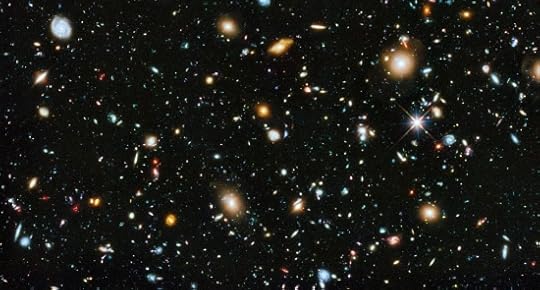
A portion of the universe as seen by the Hubble Space Telescope, using its full range of light sensitivities (ultraviolet to near-infrared).
The MSN headline is attention-grabbing, to say the least:
The Universe Should Not Actually Exist, Scientists Say
One of the things my Ph.D. advisor stressed over and over again is that there are two phrases any good scientist should be very comfortable saying. The first is, “I don’t know.” The second is, “I was wrong.” I have uttered both of those phrases throughout my career, and I am very glad that in this case, the scientists mentioned in the headline are wrong!
So why do these scientists say the universe shouldn’t exist? Well, if you don’t want to believe in a supernatural Creator, you have to figure out where the universe came from. Experiments demonstrate that even empty space contains a certain amount of energy, and our current understanding of quantum mechanics says that it is possible for energy to spontaneously be converted into particles. This is often called a quantum fluctuation, and for those who don’t want to believe in a supernatural Creator, it is a way of explaining how the universe got started. Particles sprung into existence from the energy of empty space, producing the universe we see today.
If this seems strange to you, don’t worry. You aren’t alone. As a nuclear chemist, I am well-versed in quantum theory and have no problem with the concept of particles springing into and out of existence in empty space. Nevertheless, the idea that this process can produce a universe is very strange to me as well, for a host of reasons. The MSN article linked above gives one of the most important: when particles spring into existence from energy, they must always be paired with their antiparticles. In other words, matter can, indeed, arise from the energy of empty space, but an equal amount of antimatter must be formed as well.
Now wait a minute. Isn’t antimatter just something you hear about in science fiction stories? No. Antimatter is real. Indeed, I have done experiments with the antimatter version of the electron, which is called the positron. Those who are more focused on these kinds of experiments can produce antiprotons (the antimatter version of the proton) as well . They can even combine the positron (the antielectron) and the antiproton to make the antimatter version of a hydrogen atom! Antimatter is just as real as matter, and when matter is formed from energy, an equal amount of antimatter is formed as well.
This leads to one of many problems for those who want a universe without a Creator: Where is all the antimatter? As the experts on antimatter tell us in the article linked above:
Primordial antimatter has so far never been observed in the universe, and its absence remains a major scientific enigma.
In other words, we expect that an equal amount of matter and antimatter formed the universe, but all of the original “stuff” of the universe seems to be just matter. Where is the antimatter?
As far as we can tell, it doesn’t exist. In order to “explain around” this serious problem, those who do not want to believe in a Creator tell us that the quantum fluctuation which gave rise to the universe must have produced a bit more matter than antimatter. Over time, the antimatter ended up colliding with the matter, destroying both in a process called annihilation, leaving pure energy behind. However, since a bit more matter than antimatter formed in the original quantum fluctuation, there was matter left over, and that matter is what makes up the universe that we see.
Does this explanation sound a bit weak? It should. After all, antiparticles are supposed to be exact opposites of their particle counterparts. Thus, when particles form from a quantum fluctuation, just as many antiparticles should form as well. However, suppose there is a slight difference between particles and their anti-particle counterparts. This is called an asymmetry, and it might result in slightly more matter than antimatter being formed in a quantum fluctuation. This would allow those who don’t want to believe in a Creator to explain why our universe is almost exclusively made up of matter.
That’s the reason for the MSN article’s headline. Lots of scientists have spent a lot of time studying the properties of particles and their antiparticles, and so far, no significant differences have been observed. In most cases, the experiments have been so sensitive that the particles and antiparticles have been compared to the level of a few parts per billion, indicating that particles and antiparticles don’t differ in their properties by even 0.000001%.
However, not all properties of all particle/antiparticle pairs have been studied to that level of precision. Thus, those who want to believe that the universe sprang from a quantum fluctuation still have some hope. However, that hope dwindles with each new experiment. Indeed, the MSN article I am discussing reports on a study that was recently published in the journal Nature. That study compared the magnetic strength of the proton to that of the antiproton. Previous experiments had found equal strengths at the parts per million level, but this study increased the precision by a factor of 1,000. Still, the proton and antiproton were found to be equal in their magnetic strengths.
The lead author of the study was obviously frustrated at the result, since he is the one who said that experiments like his tell us that the universe shouldn’t exist. However, he has not lost his fervent faith in the creative power of the quantum fluctuation. He is quoted in the same article as saying:
An asymmetry must exist here somewhere but we simply do not understand where the difference is. What is the source of the symmetry break? (emphasis mine)
I would have to strongly disagree with him. There may be some asymmetry between matter and antimatter. However, all the experiments so far indicate that if it exists, it is not significant. Thus, the most scientifically-reasonable position is that it doesn’t exist. Why does the lead author claim that it must exist? It’s certainly not because of the science. Perhaps it’s because of his preconceived notions of how the universe was formed.
October 19, 2017
Another Stunning Confirmation of General Relativity
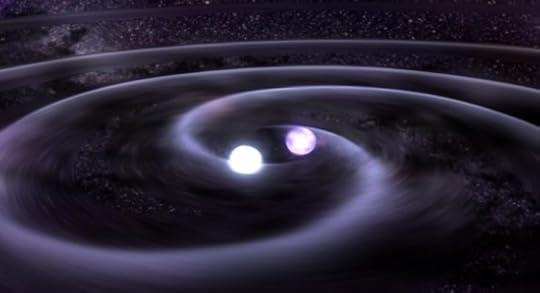
An artist’s conception of a pair of neutron stars producing gravitational waves.
Einstein’s special and general theories of relativity make some really odd predictions. Many people don’t care for those predictions, but as a scientist, I have one simple question: Are the predictions confirmed by the data? If the answer is “yes,” the theories are reasonable. The more often the answer is “yes,” the more scientifically sound the theories become. The answer has been “yes” many, many times for these theories, so regardless of how odd their predictions, I have to accept them as sound scientific theories, until another theory becomes even more successful at making such predictions.
While the special theory of relativity is strange enough, the general theory is even stranger. It predicts the existence of black holes, and those black holes have been indirectly observed. It predicts that time speeds up in low gravitational fields and slows down in high gravitational fields. Not only does the global positioning system verify this every nanosecond of every day, but it has been confirmed in the laboratory as well.
General relativity also predicts the existence of gravity waves. A special facility designed to detect such waves, the Laser Interferometer Gravitational-Wave Observatory (LIGO), made headlines last year when it finally confirmed their existence. It has since detected more gravitational waves, but with the help of other facilities, it has now done something truly amazing!
Since LIGO first detected gravitational waves, a similar European facility, Virgo, has come online. On August 14 of this year, LIGO and Virgo both detected gravitational waves from the same source, strongly increasing scientific confidence in the existence of gravitational waves. In all these cases, however, the characteristics of those waves indicate that their source was the interaction of black holes.
Gravitational waves are difficult to detect, so they must be pretty big for LIGO and Virgo to see them. The more massive the source of the waves, the larger they are, so it makes sense that black holes would be the predominant sources of the gravitational waves detected. However, on August 17th of this year, LIGO detected a gravitational wave whose characteristics indicated that it wasn’t produced by black holes. Instead, it was produced by objects that were incredibly massive, but not massive enough to trap light (neutron stars). Virgo confirmed that they had seen the same thing: a gravity wave that did not come from black holes.
Based on the two facilities’ signals, astrophysicists were able to determine the position of the gravitational wave source. Astronomers turned their telescopes to that region and they found a bright source of light that wasn’t in previous images of the same part of the sky. In other words, it was a new source of light, exactly where LIGO and Virgo said neutron stars were interacting enough to produce gravity waves and light! Analysis of the light indicates that heavy elements were being made, which one would expect from the interaction of two neutron stars.
So this is a truly stunning confirmation of general relativity. The theory predicts not only the existence of gravity waves, but it can predict what they should look like based on the type of interaction that is going on. When two detection facilities saw a gravitational wave that the theory says must have resulted from the interaction of neutron stars, astronomers turned to that patch of sky and found exactly what you would expect for such an interaction: a new source of light that indicated the presence of heavy elements!
Now I have to say that if you read what is going on in the media, they sensationalized the discovery. For example, space.com says:
The origin of the universe’s heaviest elements has mystified scientists, but after Monday’s (Oct. 16) historic announcement of the detection of gravitational waves produced by two colliding neutron stars, astronomers have struck gold — literally.
Actually, the scientific article linked above tells a different story. It definitely indicates that heavy elements were made, but it says nothing about the detection of gold. In fact, it uses three models of the nuclear physics thought to occur in neutron star interactions and “twiddles” with the parameters of those models until it gets a good fit for the light that was detected from the neutron stars. Those models indicate that some gold was made, along with a lot of other heavy elements. However, we have no idea how reliable the models are, so we have no idea whether or not gold was actually made in the interaction.
It’s sad that the media chose to overhype this discovery, because from a scientific point of view, it is a stunning discovery that needs no hype at all!
October 16, 2017
By Teaching, We Learn
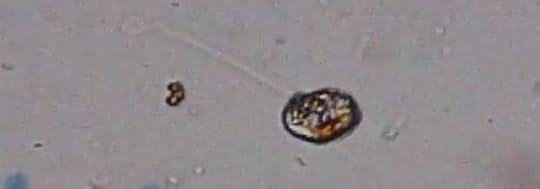
A single-celled organism from genus Anisonema, as captured by high school student Brynna Taylor.
I have a small plaque on my wall that reads, “Docendo Discimus.” It is a Latin proverb that means, “By teaching, we learn.” The very first time I helped a friend with her homework, I realized the truth of that proverb, and it is one of the reasons I enjoy teaching so much. I love to learn, and since teaching helps me to learn, I love to teach. Part of the proverb’s truth comes from the fact that as we explain things to others, we think about them in new ways, which often leads to new insights. Over the years, however, I have found other ways that teaching helps us to learn, and I experienced one of them this past weekend.
Because of the Lord’s leading, I decided to offer some online high-school courses this year. It has been a blast teaching students from all over the U.S. as well as a handful of foreign countries. Along with the joy of teaching and getting to know students, however, comes the drudgery of grading. While I love the former, I most certainly do not love the latter. However, on Saturday, I graded lab reports from my various classes.
I started with my high school biology class, which had spent the last week or so culturing pond water and looking at samples of it under the microscope. A lab like that is “hit or miss,” because finding interesting microscopic creatures in pond water depends on a lot of factors. Some students see many organisms, while other students see few or none at all. I was in the “monotony zone,” having gone through several lab reports, when I came across a submission with an excited note attached. The student, Brynna Taylor, was thrilled with what she saw, and she just had to share a few videos with me.
The first of three videos is posted (with her permission) below. She thought the organism she was focusing on was a Euglena, and while I understood her reasoning, I quickly realized she wasn’t correct. Euglena typically have only one flagellum (a tail-like appendage used to move around), and the organism she was focusing on had two. In addition, only one seemed to be used for movement. The other was pushed out in front of the organism, almost like it was using the flagellum to sense what was ahead.
I had never seen anything like that before, so I did some research and came up empty. Then I did something I rarely do. I asked my sister-in-law (who is a biology professor) for help. She has forgotten more biology than I will ever know, and I always learn more about the subject when I visit her and her husband, who is a world-renowned expert in molecular biology. However, they are both very busy people, so I don’t like to bother them unless I have no other options. I sent her the video, and she also couldn’t identify the organism. However, she gave me some ideas on how to refine my search, and I eventually learned that this interesting organism is from genus Anisonema in kingdom Protista, subkingdom Protozoa.
I have probably searched hundreds of drops of pond water under the microscope throughout my life, and I have seen a lot of “cavorting beasties,” as Anton van Leeuwenhoek referred to them when he first saw them in 1673. I thought I had pretty much seen it all, but I didn’t even know about this genus. However, because a student was excited about what she saw, I learned about a genus that was entirely new to me. My sister-in-law did as well. When I asked her to confirm my identification, she said:
That does look like the video. Good work! Protists are so hard — so darn many of them!!
While learning about a genus that is entirely new to me is interesting, I learned something even more valuable from Miss Taylor: God’s creation is so marvelously complex and diverse that there is no way you could see everything there is to see, even when you are just looking at a drop of pond water!
If you would like to see the other videos Brynna Taylor shared with me, they are given below. This one is (most likely) a Euglena:
This last one really demonstrates why Anton van Leeuwenhoek referred to microscopic organisms as “cavorting beasties.” Unlike the previous two videos (which came from a freshwater pond), this comes from a sample of ocean water. Miss Taylor had put an egg in the ocean water to give the microorganisms something to eat, and a slime developed. She put a sample of slime under the microscope, and the video below is the result. There are a lot of different microorganisms there, but the most common ones seem to be paramecia.
October 9, 2017
A Climate Skeptic’s Story
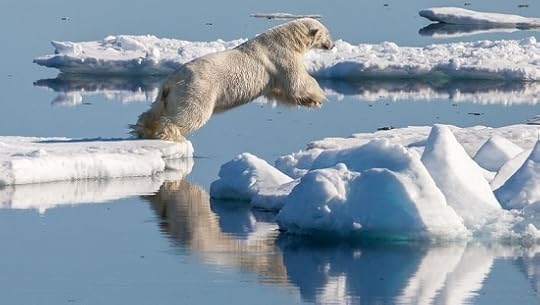
A polar bear on drift ice. (click for credit)
I was recently sent this article, which was written by a student. It’s about how she became a “climate skeptic.” It is definitely worth reading in its entirety, because it demonstrates how critical thinking can overcome indoctrination. In addition, it shows you what this critical thinking can cost, especially at the university level.
Rather than encouraging her to investigate and think for herself, her university “science” classes simply try to indoctrinate her. As she says near the end of the article:
I am disappointed by the quality of the “science” taught at University though — when theory is presented as fact, and computer models are regarded as gospel despite their infamous unreliability, it’s not actual science.
It’s propaganda—dogmatic as any religion.
Unfortunately, I have to agree with her. Even back when I was a university student, I could see examples of my “science” professors pushing propaganda on me. As a university professor, however, I have seen it become worse and worse.
But why did the student first decide to question the propaganda that was being pushed on her in the guise of science? Because of what she was being taught in middle school about global warming drowning polar bears. She was an animal “fanatic,” so she started reading about polar bears to learn more about them. In her reading, she found that they are able to swim 60 miles at a time. She asked her teacher how ice loss could harm polar bears that could swim so far. Her teacher simply told her that polar bears can’t swim that far (even though they routinely do) and then repeated the propaganda.
This caused her to start questioning what her teachers were telling her, and so she started investigating the issue of climate change for herself. As a result, she became a skeptic. Now I am sure that her middle school teacher wouldn’t want to hear this, but I think the teacher did a great service to this one student. Of course, the teacher has probably committed educational malpractice on many more students, but in the case of this one student, by simply denying the science and restating the propaganda, she taught the student to question the pronouncements that come from the high priests of science.
That’s probably the most valuable thing the student learned in middle school!
October 5, 2017
Cosmologists: Often in Error, but Never in Doubt
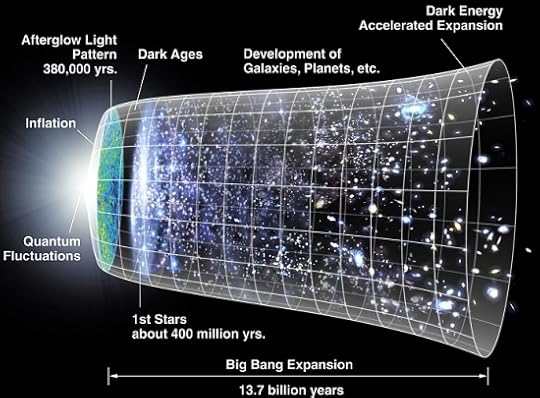
The history of the universe, according to the Big Bang Model.
In 2004, Dr. Simon Singh wrote a book entitled, Big Bang: The Most Important Scientific Discovery of All Time and Why You Need to Know About It. On page 265 of that book he attributes a quote to Dr. Lev Landau, a Nobel Laureate in physics. According to Singh, Landau said:
Cosmologists are often in error, but never in doubt.
Regardless of whether or not Dr. Landau actually said this, it is an insightful statement. Most cosmologists have absolutely no doubt that the Big Bang Model is an accurate description of the history of our universe. When that model seems to contradict observational data, rather than doubting the model, they add something to it in order to force it to be in compliance with the data.
For example, in 1998, some observational data indicated that the expansion of the universe is accelerating. This didn’t agree with the current interpretation of the Big Bang Model, which suggested that the rate of universal expansion should be decreasing, since gravity should be attracting all sources of mass to one another. As more and more data supported the acceleration, cosmologists started to rely on dark energy, a mysterious form of energy that counteracts the effects of gravity.
In the currently-accepted form of the Big Bang Model, just under 70% of all the energy of the universe is dark energy. Cosmologists don’t know anything about it, but most of them have no doubt that it exists, because it forces the Big Bang Model into compliance with observations. Since they have no doubts about the Big Bang Model, they have no doubts about the existence of dark energy. It’s just that simple.
Now, of course, I am happy to entertain the notion that nearly 70% of the universe is made up of a form of energy that we have absolutely no understanding of. I am also happy to entertain the Big-Bang-required notion that about 25% of the matter in the universe is in one or more forms of “dark matter,” which once again is matter we know nothing about. In other words, I am happy to entertain the Big Bang’s conclusion that only 5% of the universe is made up of the energy and matter that we have been able to analyze. However, those percentages should lead any reasonable person to doubt the model upon which they are based. Unfortunately, there is little doubt among cosmologists.
Recently, I ran across two studies that should lead to even more doubt. Both studies reference a mystery: inconsistent values for the Hubble Constant. In the Big Bang Model, the universe is expanding, and the rate of that expansion can be characterized by this constant. The larger the constant, the faster the universe is expanding. However, two different high-precision measurements provide different results. Based on the characteristics of observed supernovas, the Hubble Constant is supposed to be 73.24 +/- 1.74 km/(sMPc). The “+/-” part is the error bar, which indicates precision. The smaller the error bar, the more precise the measurement. However, analysis of background radiation that seems to be coming from everywhere in the universe indicates that the Hubble Constant should be 66.93 +/- 0.62 km/(sMPc).
Now error bars aren’t perfect. All they say is that the value should lie within the range given by the error bar. However, notice that if you subtract two error bars from the first value of the Hubble Constant, you get 69.76. If you add two error bars to the second value, you get only 68.17. So even if you double the error bars, you can’t get the two values to agree. Of course, I am skeptical of the error bars to begin with, but remember, most cosmologists have no doubt, so they think the error bars are completely accurate.
How are they supposed to reconcile these values? According to their model (which is true, no doubt) they should be the same. That’s where the two studies I recently read come in. The first study says that the problem lies in an assumption made about dark energy. Currently, cosmologists think that dark energy had a constant contribution to the expansion of the universe throughout its history. The study says that if you allow that contribution to vary, you can understand the discrepancies between the two values of the Hubble Constant.
The second study doesn’t refer to dark energy at all. Instead, it uses observational evidence to indicate that the earth (indeed, the entire Milky Way Galaxy) exists in a part of the universe that is unusually sparse when it comes to matter. Well, the first Hubble Constant measurement I listed is based on the assumption that over large distances, the universe is pretty uniform. This is called the cosmological principle, and despite the fact that observations demonstrate that it cannot be correct, most cosmologists have no doubt that it is, because it is a fundamental principle of the Big Bang Model. So this study says that the first value I reported can be ignored, because it is based on an assumption that is wrong.
Now don’t get me wrong. I am not “poking fun” at these studies or trying to say that they aren’t valuable. Obviously, the more data we have, the more we can try to understand the universe. What I am “poking fun” at is the unwavering faith of cosmologists. In order to fix a problem associated with the Big Bang Model, we either add more complexity to something that has already been added to fix the Big Bang Model (dark energy), or we ignore the cosmological principle, which is fundamental to the Big Bang Model. But none of this can lead to any doubt in the Big Bang Model itself!
Fortunately, not all cosmologists are so fervent in their faith. There are those precious few cosmologists who are willing to doubt the Big Bang Model and explore other possibilities when it comes to the history of the universe. Despite the fact that such cosmologists can be under a lot of pressure to conform, I pray that they continue to follow the data and not wed themselves to the currently-fashionable model.
October 2, 2017
An Award-Winning Play

From left to right: Cameron Gamble, Andrew Persinger, and Natalie Gamble in “Amazing Grace.”
Six years ago, I wrote a play for church. It was called “John Newton: A Wretched and Admirable Man,” and I performed it with Chris Williams, who went home to be with the Lord earlier this year. While he was still with us here on earth, I learned about The Greenberg Playwright Competition, which was organized to seek writing talent in the state of Indiana. I talked to Chris about it, and he suggested that I submit that play.
I decided I would follow Chris’s advice, and I looked at the script, thinking I would just “tweak” it a bit and send it in. However, when I finished reading it, I thought to myself, “I remember it being better than this.” So I decided to watch the video, and I realized that it was, indeed, much better than my initial script. That’s because Chris, who played the role of Nigel Bremley, had adjusted his lines, and the other actors adjusted in response. The result was much better dialogue than what I originally wrote.
So I rewrote the script based on the video, retitled it as “Amazing Grace,” sent it in, and it won one of the categories! As a result, it was assigned a professional director, David Coolidge, and three talented actors (Cameron Gamble, Natalie Gamble, and Andrew Persinger). They worked on the script, improving it even further, and they ended up delivering an incredible performance at The Alley Theatre in Anderson, Indiana. They were all generous enough to agree to perform it the next day at my church, and I tried to get a video of it.
Churches aren’t really made for videos, so the result is not what I had hoped for. Also, one of the cameras failed, so the end of the play, which is the most dramatic part, had to be finished with a poor-quality camera. If you watch the video, you will see what I mean. Below the video, I have a link to the script. Please feel free to use it in any way you think will edify the Body of Christ, but I do request a credit as the author.
September 25, 2017
A Positive Step for Science
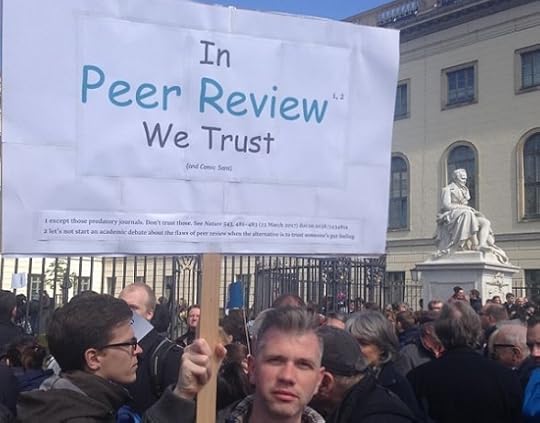
A man holds a sign at the International Science March outside Humbolt University (Berlin) on April 22nd, 2017. (click for credit)
When I submit a paper to a scientific journal, it is reviewed by experts in the field before it is published. The experts might say that the paper should be published as it is. They might say that the paper should be published, but certain changes should be made to either make it more consistent with what we know or to provide better context for understanding the results that are being presented. The reviewers might say that the article shouldn’t be published, because it contains poor science or because the results aren’t important. This is the process of peer review.
I have been on both sides. I have submitted papers for publication that went through peer review, and I have been a peer reviewer for scientific journals in my area of expertise. Although neither process is particularly enjoyable, I think it is a very important part of science. Indeed, even though it is not required, I have all of my science texts reviewed by at least two experts before they are sent to the publisher. These experts often catch errors that I have made, and they also add valuable comments that allow me to improve the way I discuss certain topics. My textbooks are significantly better because they are peer-reviewed.
Of course, there is also a problem with peer review. It can lead to the suppression of scientific results for unscientific reasons. I have experienced this personally. I recall one paper that my collaborators and I submitted to a nuclear physics journal. It was rejected by the peer reviewers, and the journal said that it would not be published. We looked at the reports of the peer reviewers and showed the editor that the reviewers’ objections were without merit. The journal agreed to send it to two more peer reviewers, who both accepted it with only minor corrections.
We later learned that the two peer reviewers who rejected the paper were from research teams who had published papers that our results contradicted. They rejected the paper not because it was poor, but because they didn’t want their results challenged. Fortunately, it was easy for us to show that their rejections didn’t make sense, because their review reports clearly demonstrated the weakness of their case. They apparently thought that since these reports are confidential (shared only with the editor and the team trying to publish the paper), they could use technical jargon to convince the editor that they were right, and no one would be the wiser.
That’s the dark side of peer review. Fortunately, there is a new trend in scientific publication, and if it catches on, it will greatly diminish this dark side. It’s called open peer review.
The Royal Society (the oldest independent scientific academy in the world) has been doing this since 2014. If the authors and reviewers agree, the journal Royal Society Open Science will publish a scientific paper along with the relevant parts of the peer reviewers’ comments. That way, all readers will see not only what the authors think, but also what the peer reviewers think. This seems to be catching on, because the Royal Society says that more than half of the papers published in Royal Society Open Science have open peer review. The numbers vary with discipline, however. About 85% of their physics papers were published with open peer review, while slightly less than 50% of their genetics papers were published that way. Other journals like the British Medical Journal and PloS ONE have been experimenting with open peer review as well.
I do hope this becomes more and more popular. Peer review is a very important part of science, but as we know, it is becoming more and more popular to weaponize science for political and social causes. Confidential peer review makes this weaponization of science easier, while open peer review makes it harder. In addition, I like the idea of reading a scientific paper and then reading what some experts in the field think of it.
Now before I finish, I want to make it clear that peer review is not a perfect system, and open peer review will only help it to a certain extent. There are still times where even open peer review will lead to the suppression of good science. When a paper challenges the “scientific consensus,” for example, it might still be blocked, regardless of its merits. Nevertheless, open peer review seems better than the system that currently exists, and I think that, on balance, it is a positive step for science.
Jay L. Wile's Blog
- Jay L. Wile's profile
- 31 followers



